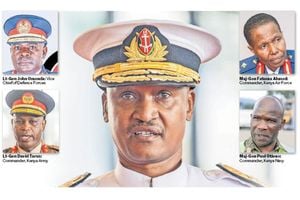Built with German technology, TGRV track a roaring success

A driver goes through his paces at the well maintained The Great Rift Valley track aka TGRV go-karting circuit at Maai Mahiu on August 9, 2020.
What you need to know:
- However, he said their main consolation after completing the facility is the increasing number of visitors from Naivasha, Nairobi, Mombasa, and Nakuru who troop to the the facility every weekend.
- "The Standard Gauge Railway (SGR) is just 10 minutes away and we hope it will open up the area and the government has plans to tarmac the road leading to our facility and this makes accessibility easy," he said.
A mention of Maai Mahiu brings to mind the traffic snarl ups of freight trucks along the busy Naivasha-Maai Maihiu road.
But unknown to many, the busy trading centre which is just some 43km away from the capital city Nairobi is becoming the next major go-karting venue in Kenya.
Located some 4.2km off Narok-Maai Mahiu highway, it is a thrilling venue to relax with family and friends as you experience the world of motorsport.
The go-karting site has in the past hosted Adrenalin-packed racing series both for beginners and experienced racers in the country.
Welcome to The Great Rift Valley track popularly known as TGRV track by go-karting enthusiasts in the country.
The man behind one of the best kept sporting infrastructure in the country is Raj Dadhley.
On a visit to the 28-acre go-karting facility, you will be forgiven to think that you are stepping on to a track in Europe.
But what amazes first-time visitors to this facility is that if a family can invest millions of shillings and construct such a magnificent track, then the government can do better on the decaying sporting infrastructure in the country such as stadiums.
Flagship development
TGRV is a family flagship development project that can be used as benchmarking visit on how to build and manage sports facilities.
Set on the floor of the scenic Rift Valley floor, sandwiched between the four mountains namely Mt Suswa on south west, Mt Margret on northwest side and Mt Kenton on northern side and overlooking the rolling escarpment on the eastern side, the site has a 1.2km go-karting track built to CFI international standards.
Watching the adrenalin producing race as young thrill-seekers press the gas pedal of their machines, training under the close watch of Dadhley and his team of assistants, there is no doubt this is a circuit above the rest.
Besides, the smooth track, the 12 rooms clubhouse, where one can sample African, Indian and Chinese cuisine, is an architectural masterpiece that is surrounded by a canopy of trees that welcomes you from the entrance as you leave behind swirling brown dust thanks to the poor state of the road leading the facility.
"We came across this idea when my sons Jaivir 'Xav', Zoravar, and Ranvir got interested in go-karting and we did a few races in Europe and visited between 10-15 tracks. “When we got back home the kids missed competitive racing and proper tracks because what was here at that time was not competitive enough for them and that is how we decided to acquire this facility to promote the sport for all Kenyans, " said Dadhley who is also the chief executive officer of TGRV circuit.
"Since that time we have not looked back and the sky is the limit," added Dadhley who is a civil engineer by profession.
And his gamble to construct the multi-million track has paid dividends as his son Jaivir, 16, who is a seven-time national champion and an FI driver for Kenya, represented the country in the world Academy Go-karting World Academy final in France. He is a product of the track.
Jeremy Wahome racing in Formula 3 in Europe has also raced at the track.
His other sons, Zoravor, 13, is a two-time national go-karting champion while his youngest son Ranvir, 6, is the reigning 50cc go-kart champion.
Walk in the park
According to Dadhley, 47, starting the facility was not a walk in the park.
"Logistically starting the project was not easy as we found the flat terrain and soil conditions were pretty good but building the main facility was a big challenge as there was no infrastructure such as roads and accessing it was very difficult. We had to construct the road to enable us to access the construction venue."
Besides, poor roads, the area had no water and electricity supply.
However, he said their main consolation after completing the facility is the increasing number of visitors from Naivasha, Nairobi, Mombasa, and Nakuru who troop to the the facility every weekend.
"The Standard Gauge Railway (SGR) is just 10 minutes away and we hope it will open up the area and the government has plans to tarmac the road leading to our facility and this makes accessibility easy," he said.
Dadhley revealed that the track design was drawn by an engineer from Germany.
The track combines features of some of the most competitive tracks in German and has room to expand to cater for open-wheel racing.
He added: "The tarmac mix which is special was done in German and for the past four years it has never cracked."
"After Covid-19 is contained we have plans to expand the facility to open-wheel racing as Kenyans have a big thirst for racing bikes and we hope to attract more motorsport enthusiasts in Kenya with the right facilities, to grow the talents" he added.
The circuit employs about 20 people.




